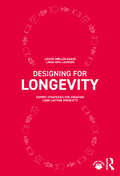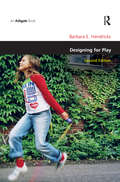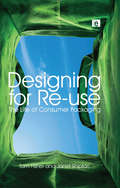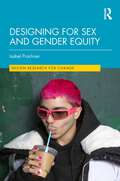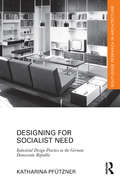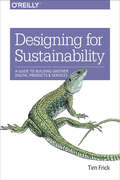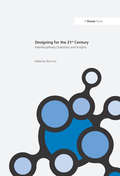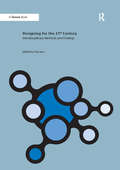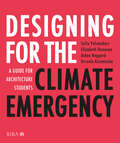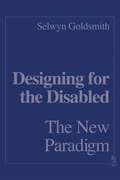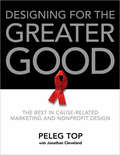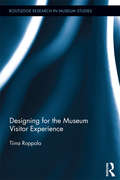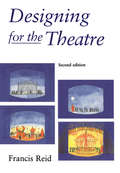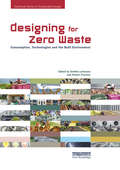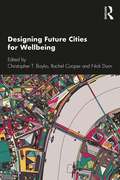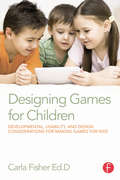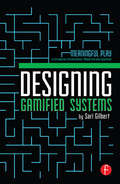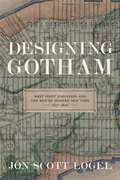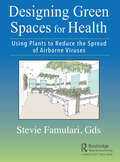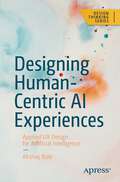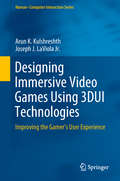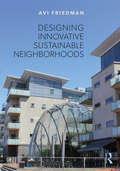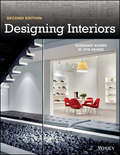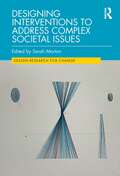- Table View
- List View
Designing for Longevity: Expert Strategies for Creating Long-Lasting Products
by Louise Møller Haase Linda Nhu LaursenProduct longevity is one of the cornerstones in the transition towards a more sustainable society and a key driver for the circular economy model. This book provides designers, developers, and creators with five distinctive expert strategies, detailed case studies, action guides and worksheets that support both beginning and advanced design practitioners in creating new product concepts with long-lasting strategic fits. Designing for Longevity shows how expert design teams create original and long-lasting product concepts from the early development phase. It focuses on integrating business knowledge, market conditions, company capabilities, technical possibilities and user needs into product concepts to make better strategic decisions. It demonstrates how, for products to be durable, designers must create a long-lasting strategic fit for the customer, company, and market. Key case studies of products such as Bang & Olufsen’s A9, LEGO Ninjago and Friends and Coloplasts’ Sensura Mio, among others, offer readers inspiration, guidance and real-world insights from design teams showing how the strategies can be applied in practice. Action guidelines and worksheets encourage broad, analytical problem-solving to identify and think through challenges at the early concept stage. Beautifully designed and illustrated in full colour throughout, this book combines original research and the hands-on tools and strategies that design practitioners need to create useful, sustainable products.
Designing for Play (Design and the Built Environment)
by Barbara E. HendricksArchitects, landscape designers, builders, gardeners and teachers have all at some time been called upon to design a play area. Unfortunately, this diversity has not resulted in a similar diversity of design solutions for this very problematic task. Despite a proliferation of 'how to' books on this subject, playgrounds have remained virtually the same throughout the world since their creation over a century ago. This is not a 'how to' design book. Instead, based on thirty years' experience as a specialist play area designer, Barbara Hendricks details a radically new approach, applying cutting-edge thinking from child development and child psychology to find innovative design solutions, challenging the established notions of play provision. Covering key sociological, public policy, environmental and design issues, this book provides designers with an exploration of and guide to, designing from a 'child's eye' view of the world. Beautifully crafted and copiously illustrated with numerous examples of recently designed playgrounds, this book is not only stimulating and informative, but fun to read and seriously playful in itself. This second edition brings the text up to date from 2001 to 2010 with added discussion about new ideas for play area designs and what has not worked in the past decade.
Designing for Re-Use: The Life of Consumer Packaging
by Tom Fisher Janet ShiptonPackaging is ephemeral - its purpose is to be 'wasted' once we've removed the product it contains. Whilst we are encouraged to 'reduce, re-use and recycle', Designing for Re-Use proposes that domestic re-use is the 'Cinderella' of this trinity, because it is under researched and little understood. The re-use of packaging could have a significant effect on the quantity of material that enters the waste stream and the energy and consequently carbon that is expended in its production - every re-used item is another item not purchased. The authors demonstrate that we do re-use - but usually despite, rather than because of, the actions of government and designers. The book shows that by understanding the ways in which actions of this sort fit with everyday life, opportunities may be identified to enhance the potential for re-use through packaging design. The authors itemize the factors that affect the re-use of packaging, and analyse the home as a system in which objects are processed. Some of these factors relate to the specifics of the design, including the type of materials used and the symbolism of the branding. Other factors are more obviously social - for instance the effects on re-use of different consumer orientations. The book provides practical guidance from a design perspective, in the context of real-life examples, to provide professionals with vital design recommendations and evaluate how a practice orientated approach to understanding consumers' behaviour is significant for moving towards sustainability through design.
Designing for Sex and Gender Equity (Design Research for Change)
by Isabel ProchnerDrawing on original designer interviews, this book explores how design interventions can and do support sex and gender equity and what barriers still stand in the way. Isabel Prochner not only brings attention to sex and gender problems related to design artifacts but also provides a unique overview of creative design responses to these issues. The case studies and designer interviews provide new information about how designers can address these issues and the challenges they may encounter—whether that’s a lack of anthropometric data, trouble finding investment and business support, or even public resistance. Prochner brings together primary and secondary research and the most contemporary theories on sex, gender, and design. This book will be of interest to scholars working in design studies, sex and gender studies, social design, design for health, industrial design, product design, fashion design, and interaction design.
Designing for Socialist Need: Industrial Design Practice in the German Democratic Republic (Routledge Research in Architecture)
by Katharina PfütznerHow does industrial design operate outside of capitalist consumer culture? Designing for Socialist Need assembles a detailed picture of industrial design practice in the socialist German Democratic Republic (GDR). Drawing on much previously unexplored material from a wide variety of sources, it not only maps out some of the ideological, institutional and economic contexts within which GDR design functioned, it also critically reconstructs the designers’ aims and perspectives in order to argue that they shared a profoundly socially responsible approach to design. By focusing on their ideas and approaches, this volume attends to the previously unacknowledged intellectual and practical richness of GDR design culture and demonstrates that it can provide pertinent insights not only for scholars of GDR history or German design, but also for contemporary design practitioners, theorists and educators with an interest in sustainability in design.
Designing for Sustainability: A Guide to Building Greener Digital Products and Services
by Tim FrickPixels use electricity, and a lot of it. If the Internet were a country, it would be the sixth largest in terms of electricity use. That's because today's average web page has surpassed two megabytes in size, leading to slow load times, frustrated users, and a lot of wasted energy. With this practical guide, your web design team will learn how to apply sustainability principles for creating speedy, user-friendly, and energy-efficient digital products and services.Author Tim Frick introduces a web design framework that focuses on four key areas where these principles can make a difference: content strategy, performance optimization, design and user experience, and green hosting. You'll discover how to provide users with a streamlined experience, while reducing the environmental impact of your products and services.Learn why 90% of the data that ever existed was created in the last yearUse sustainability principles to innovate, reduce waste, and function more efficientlyExplore green hosting, sustainable business practices, and lean/agile workflowsPut the right things in front of users at precisely the moment they need them--and nothing moreIncrease site search engine visibility, streamline user experience, and make streaming video more efficientUse Action Items to explore concepts outlined in each chapter
Designing for the 21st Century: Volume I: Interdisciplinary Questions and Insights
by Tom InnsAs we become familiar with the 21st century we can see that what we are designing is changing, new technologies support the creation of new forms of product and service, and new pressures on business and society demand the design of solutions to increasingly complex problems, sometimes local, often global in nature. Customers, users and stakeholders are no longer passive recipients of design, expectations are higher, and increased participation is often essential. This book explores these issues through the work of 21 research teams. Over a twelve-month period each of these groups held a series of workshops and events to examine different facets of future design activity as part of the UK's research council supported Designing for the 21st Century Research Initiative. Each of these 21 contributions describes the context of enquiry, the journey taken by the research team and key insights generated through discourse. Editor and Initiative Director, Tom Inns, provides an introductory chapter that suggests ways that the reader might navigate these different viewpoints.
Designing for the 21st Century: Volume II: Interdisciplinary Methods and Findings
by Tom InnsAs we become familiar with the 21st century we can see that what we are designing is changing, new technologies support the creation of new forms of product and service, and new pressures on business and society demand the design of solutions to increasingly complex problems, sometimes local, often global in nature. Customers, users and stakeholders are no longer passive recipients of design, expectations are higher, and increased participation is often essential. This book explores these issues through the work of 21 research teams. Over a twelve-month period each of these groups held a series of workshops and events to examine different facets of future design activity as part of the UK's research council supported Designing for the 21st Century Research Initiative. Each of these 21 contributions describes the context of enquiry, the journey taken by the research team and key insights generated through discourse. Editor and Initiative Director, Tom Inns, provides an introductory chapter that suggests ways that the reader might navigate these different viewpoints.
Designing for the Climate Emergency: A Guide for Architecture Students
by Sofie Pelsmakers Aidan Hoggard Urszula Kozminska Elizabeth DonovanWe are in a climate emergency. Architects must be part of the radical change needed. This book guides architecture student to create truly sustainable designs. Demonstrating holistic design approaches through 10 key themes, it guides students through the different stages of the design process in five illustrated chapters. Reflecting the years of study, it provides step-changes towards eventual architecture practice. Unique features include key checklists, case studies, student examples and an extensive glossary.
Designing for the Disabled: The New Paradigm
by Selwyn GoldsmithSelwyn Goldsmith's Designing for the Disabled has, since it was first published in 1963, been a bible for practising architects around the world. Now, as a new book with a radical new vision, comes his Designing for the Disabled: The New Paradigm.Goldsmith's new paradigm is based on the concept of architectural disability. As a version of the social model of disability, it is not exclusively the property of physically disabled people. Others who are afflicted by it include women, since men customarily get proportionately four times as many amenities in public toilets as women - and women have to queue where men do not - and those with infants in pushchairs, because normal WC facilities are invariably too small to get a pushchair and infant into.To counter architectural disability, Goldsmith's line is that the axiom for legislation action has to be 'access for everyone' - it should not just be 'access for the disabled', as it presently is with the Part M building regulation and relevant provisions of the 1995 Disability Discrimination Act. In a 40-page annex to his book he sets out the terms that a new-style Part M regulation and its Approved Document might take, one that would cover alterations to existing buildings as well as new buildings. But architects and building control officers need not, he says, wait for new a legislation to apply new practical procedures to meet the requirements of the current Part M regulation; they can, as he advises, act positively now.This is a book which will oblige architects to rethink the methodology of designing for the disabled. It is a book that no practising architect, building control officer, local planning officer or access officer can afford to be without.
Designing for the Greater Good
by Peleg Top Jonathan ClevelandThis first-ever book of its kind, Designing for the Greater Good, features hundreds of illustrated examples of the best nonprofit and cause-related design worldwide, plus 24 inspiring case studies and insights into great nonprofit branding campaigns. A comprehensive resource for designers, creative professionals, marketers, corporate communications departments and nonprofit leaders, this book showcases work from a variety of sectors including Family and Community, Animal Causes, Health, Human Rights, Environmental Awareness, Spirituality, and the Arts. The 24 case studies feature interviews with the designers for such campaigns as the Avon Walk for Breast Cancer, The Hurricane Katrina Poster Project and Get London Reading. Materials presented in Designing for the Greater Good include: cause-specific campaigns and case studies; logos and branding for nonprofits; websites, posters, brochures, advertising, and marketing materials for cause-related events and nonprofits; packaging; invitations for fundraisers and events.
Designing for the Museum Visitor Experience (Routledge Research in Museum Studies #5)
by Tiina RoppolaExhibition environments are enticingly complex spaces: as facilitators of experience; as free-choice learning contexts; as theaters of drama; as encyclopedic warehouses of cultural and natural heritage; as two-, three- and four-dimensional storytellers; as sites for self-actualizing leisure activity. But how much do we really know about the moment-by-moment transactions that comprise the intricate experiences of visitors? To strengthen the disciplinary knowledge base supporting exhibition design, we must understand more about what ‘goes on’ as people engage with the multifaceted communication environments that are contemporary exhibition spaces. The in-depth, visitor-centered research underlying this book offers nuanced understandings of the interface between visitors and exhibition environments. Analysis of visitors’ meaning-making accounts shows that the visitor experience is contingent upon four processes: framing, resonating, channeling, and broadening. These processes are distinct, yet mutually influencing. Together they offer an evidence-based conceptual framework for understanding visitors in exhibition spaces. Museum educators, designers, interpreters, curators, researchers, and evaluators will find this framework of value in both daily practice and future planning. Designing for the Museum Visitor Experience provides museum professionals and academics with a fresh vocabulary for understanding what goes on as visitors wander around exhibitions.
Designing for the Theatre (Stage And Costume Ser.)
by Francis ReidNow in its second edition, Designing for the Theatre has established itself as the authoritative introduction to the processes of design for the theatre. Covering the contribution which can be made by costume, sets, props and lighting to a stage production, the author explains the purpose and process involved in their design. Included in this second edition are new photographs and drawings illustrating some of the most exciting and diverse current trends in stage design.
Designing for Zero Waste: Consumption, Technologies and the Built Environment
by Steffen Lehmann Robert CrockerDesigning for Zero Waste is a timely, topical and necessary publication. Materials and resources are being depleted at an accelerating speed and rising consumption trends across the globe have placed material efficiency, waste reduction and recycling at the centre of many government policy agendas, giving them an unprecedented urgency. While there has been a considerable literature addressing consumption and waste reduction from different disciplinary perspectives, the complex nature of the problem requires an increasing degree of interdisciplinarity. Resource recovery and the optimisation of material flow can only be achieved alongside and through behaviour change to reduce the creation of material waste and wasteful consumption. This book aims to develop a more robust understanding of the links between lifestyle, consumption, technologies and urban development.
Designing Future Cities for Wellbeing
by Christopher T. BoykoDesigning Future Cities for Wellbeing draws on original research that brings together dimensions of cities we know have a bearing on our health and wellbeing – including transportation, housing, energy, and foodways – and illustrates the role of design in delivering cities in the future that can enhance our health and wellbeing. It aims to demonstrate that cities are a complex interplay of these various dimensions that both shape and are shaped by existing and emerging city structures, governance, design, and planning. Explaining how to consider these interconnecting dimensions in the way in which professionals and citizens think about and design the city for future generations’ health and wellbeing, therefore, is key. The chapters draw on UK case and research examples and make comparison to international cities and examples. This book will be of great interest to researchers and students in planning, public policy, public health, and design.
Designing Games for Children: Developmental, Usability, and Design Considerations for Making Games for Kids
by Carla FisherWhen making games for kids, it’s tempting to simply wing-it on the design. We were all children once, right? The reality is that adults are far removed from the cognitive changes and the motor skill challenges that are the hallmark of the developing child. Designing Games for Children, helps you understand these developmental needs of children and how to effectively apply them to games. <P><P> Whether you’re a seasoned game designer, a children's media professional, or an instructor teaching the next generation of game designers, Designing Games for Children is the first book dedicated to service the specific needs of children's game designers. This is a hands-on manual of child psychology as it relates to game design and the common challenges designers face. <P><P> Designing Games for Children is the definitive, comprehensive guide to making great games for kids, featuring: <li> Guidelines and recommendations divided by the most common target audiences – babies and toddlers (0-2), preschoolers (3-5), early elementary students (6-8), and tweens (9-12). <li> Approachable and actionable breakdown of child developmental psychology, including cognitive, physical, social, and emotional development, as it applies to game design <li> Game design insights and guidelines for all aspects of game production, from ideation to marketing
Designing Gamified Systems: Meaningful Play in Interactive Entertainment, Marketing and Education
by Sari GilbertDesigning Gamified Systems is a fundamental guide for building essential skills in game and interaction design to revitalize and reimagine real world systems – from cities and corporations to schools and the military. Author Sari Gilbert develops a set of core principles and tools for using game thinking and interactive design to build motivation, explain hard concepts, broaden audiences, deepen commitments and enhance human relationships. Designing Gamified Systems includes: Topics such as gamified system design, behavioral psychology, marketing, business strategy, learning theory and instructional design Interviews with leaders and practitioners in this emerging field who explain how the job of the game designer is being redefined Exercises designed to both encourage big-picture thinking about gamified systems and help you experience and understand the challenges and nuances involved in designing them A companion website (www.gamifiedsystems.com) with additional materials to supplement learning and practice
Designing Gotham: West Point Engineers and the Rise of Modern New York, 1817-1898 (Conflicting Worlds: New Dimensions of the American Civil War)
by Jon Scott LogelBetween 1817 and 1898, New York City evolved from a vital Atlantic port of trade to the center of American commerce and culture. With this rapid commercial growth and cultural development, New York came to epitomize a nineteenth-century metropolis. Although this important urban transformation is well documented, the critical role of select Union soldiers turned New York engineers has, until now, remained largely unexplored. In Designing Gotham, Jon Scott Logel examines the fascinating careers of George S. Greene, Egbert L. Viele, John Newton, Henry Warner Slocum, and Fitz John Porter, all of whom studied engineering at West Point, served in the United States Army during the Civil War, and later advanced their civilian careers and status through the creation of Victorian New York.These influential cadets trained at West Point in the nation’s first engineering school, a program designed by Sylvanus Thayer and Dennis Hart Mahan that would shape civil engineering in New York and beyond. After the war, these industrious professionals leveraged their education and military experience to wield significant influence during New York’s social, economic, and political transformation. Logel examines how each engineer’s Civil War service shaped his contributions to postwar activities in the city, including the construction of the Croton Aqueduct, the creation of Central Park, and the building of the Brooklyn Bridge. Logel also delves into the administration of New York’s municipal departments, in which Military Academy alumni interacted with New York elites, politicians, and civilian-trained engineers. Examining the West Pointers’ experiences—as cadets, military officers during the war, and New Yorkers—Logel assesses how these men impacted the growing metropolis, the rise of professionalization, and the advent of Progressivism at the end of the century.
Designing Green Spaces for Health: Using Plants to Reduce the Spread of Airborne Viruses
by Stevie FamulariThis book focuses on using plants in spatial design to reduce the infectiousness of viruses in different working and living spaces. It presents strategies for interior and exterior green designs with plants that are likely effective for flu virus tolerance and reduction of infectiousness. The designs are appealing for interaction and healing, as well as focusing on the reduction and removal of virus infectiousness. The Famulari Theory requires examining plants that are likely effective for virus accumulation based on their leaves with stomata, trichomes, and dense leaf growth, and transpiration rate accumulation of airborne viruses. In addition, this research requires reviewing the quantity and specific types of plants (as well as electronic sources, such as humidifiers and water features) needed to produce effective humidity for plants to decrease the infectiousness or transmission of viruses; the effective distance of people to plants; and light, water, soil, and temperature needs. The book addresses the various greening practices that can be applied to sites to reduce the infectiousness of the airborne flu virus – especially in areas such as train stations, restaurants, rooftops, courtyards, office buildings and work spaces/conference rooms, and the home office – and the ways that businesses owners and residents can integrate these practices to reduce the air contaminants with a green solution. Designing green spaces that accumulate, reduce, and remove the infectiousness of viruses involves exploring multiple approaches from different directions to achieve the most effective and ideal design. The six basic approaches include 1. Temperature minimum of 70° Fahrenheit 2. Plants with multiple stomata on the leaf surfaces 3. Plants with multiple clumps of dense leaves with a high transpiration rate 4. Plants with rough leaf surfaces or with trichomes (plant hairs) on the leaf 5. Relative humidity (RH) minimum of 43% or higher 6. Air circulation to direct air with the airborne flu virus to the planted areas Stevie Famulari brings unique insights and inspires the development of green understanding and design solution plans with both short-term and long-term approaches. Illustrations of greening applied to locations help you understand your own design solutions to create them in your site. This book breaks down the misconceptions of the complexity of sustainability and green practices and provides illustrations and site-appropriate green solutions that you can incorporate into your lifestyle for a healthier site. Greening is a lifestyle change, and this guide lets you know how easy it is to transition to the green side to improve your health.
Designing Human-Centric AI Experiences: Applied UX Design for Artificial Intelligence (Design Thinking)
by Akshay KoreUser experience (UX) design practices have seen a fundamental shift as more and more software products incorporate machine learning (ML) components and artificial intelligence (AI) algorithms at their core. This book will probe into UX design’s role in making technologies inclusive and enabling user collaboration with AI. AI/ML-based systems have changed the way of traditional UX design. Instead of programming a method to do a specific action, creators of these systems provide data and nurture them to curate outcomes based on inputs. These systems are dynamic and while AI systems change over time, their user experience, in many cases, does not adapt to this dynamic nature. Applied UX Design for Artificial Intelligence will explore this problem, addressing the challenges and opportunities in UX design for AI/ML systems, look at best practices for designers, managers, and product creators and showcase how individuals from a non-technical background can collaborate effectively with AI and Machine learning teams. You Will Learn:Best practices in UX design when building human-centric AI products or featuresAbility to spot opportunities for applying AI in their organizationsAdvantages and limitations of AI when building software productsAbility to collaborate and communicate effectively with AI/ML tech teams • UX design for different modalities (voice, speech, text, etc.)Designing ethical AI system
Designing Immersive Video Games Using 3DUI Technologies: Improving The Gamer's User Experience (Human–Computer Interaction Series)
by Joseph J. LaViola Jr. Arun K. KulshreshthA 3D user interface (3DUI) is an interface in which the user performs tasks in three dimensions. For example, interactions using hand/body gestures, interaction using a motion controller (e.g. Sony PlayStation Move), interaction with virtual reality devices using tracked motion controllers, etc. All these technologies which let a user interact in three dimensions are called 3D user interface technologies.These 3D user interfaces have the potential to make games more immersive & engaging and thus potentially provide a better user experience to gamers. Although 3D user interface technologies are available for games, it is unclear how their usage affects game play and if there are any user performance benefits. This book presents state of the art research on exploring 3D user interface technologies for improving video games. It also presents a review of research work done in this area and describes experiments focused on usage of stereoscopic 3D, head tracking, and hand gesture-based control in gaming scenarios. These experiments are systematic studies in gaming environments and are aimed at understanding the effect of the underlined 3D interface technology on the gaming experience of a user. Based on these experiments, several design guidelines are presented which can aid game designers in designing better immersive games.
Designing in Ivory and White: Suzanne Perron Gowns from the Inside Out (Southern Literary Studies)
by Suzanne Perron Brian Baiamonte Jason Cohen Susan LangenhennigThe name "Suzanne Perron" is synonymous with exquisite detail. Her expertly tailored gowns -- worn at the elaborate balls of Mardi Gras and down the aisle at New Orleans weddings -- draw from the legacy of couture design. After years working alongside Vera Wang, Carolina Herrera, Anna Sui, and Ralph Rucci in New York, Louisiana native Perron returned home in 2005 to open her own custom design business, specializing in once-in-a-lifetime gowns for brides, debutantes, and Mardi Gras royalty. Designing in Ivory and White captures the rise of this talented designer, from her first Singer sewing machine to her success on Seventh Avenue to her post-Katrina move to a city in need of "something beautiful," as well as her design technique and meticulous craft. In addition to her personal story, Perron shares her process from the inside out, including: methods for creating crinolines and foundations; using draping and pattern making to transform a sketch into a three-dimensional form; manipulating fabric into pleats, pintucks, and folds; and hand sewing intricate beading, lace, embroidery, and flawless hems.Her techniques and breathtaking artistry are realized through a showcase of sixteen Suzanne Perron designs. Full-length and detail shots illustrate Perron's gorgeous silhouettes and masterful handwork. Each gown also has a story that illuminates the client experience from the first sketch to the final fitting.Designing in Ivory and White serves as a testament to the ambition and skill required to design unique dresses, and will provide inspiration for independent designers, sewing hobbyists, and all who admire couture fashion.
Designing Innovative Sustainable Neighborhoods
by Avi FriedmanThis book covers fundamental aspects of neighborhood planning and architecture along sustainable principles. Written by a designer and instructor, the book’s fully illustrated chapters provide detailed insights into contemporary strategies that architects, planners and builders are integrating into their thought processes and residential design practices. Past approaches to planning and design modes of dwellings and neighborhoods can no longer sustain new demands and require innovative thinking. This book explores new outlooks on neighborhood design, which are propelled by fundamental changes that touch upon environmental, economic and social aspects. It presents contemporary well-designed and illustrated examples of communities and detailed analysis of topics including the depletion of non-renewable natural resources, elevated levels of greenhouse gas emissions and climate change. It also explores the increasing costs of material, labor, land and infrastructure, which pose economic challenges; as well as social challenges including the need for walkable communities and the increase in live-work environments. The need to think innovatively about neighborhoods is at the core of this book, which will be useful to students and practitioners of urban design, urban planning, geography and urban systems; and to architecture studios focused on sustainable residential development.
Designing Interiors
by W. Otie Kilmer Rosemary KilmerAfter its publication in 1992, Designing Interiors became a hugely successful reference tool and designing textbook. In Designing Interiors, Second Edition, updates on trends in sustainability and green design, building codes, universal design, and building information models amplify the already invaluable interior design tricks of trade. Design professors Rosemary and Otie Kilmer provide a fuller design history that incorporates non-Western design and dynamic color illustrations that flesh out technical concepts.
Designing Interventions to Address Complex Societal Issues (Design Research for Change)
by Sarah MortonThis edited volume is about the application of design-led approaches for developing interventions that have the intention of addressing real-world issues and problems. The book documents the realities of developing and designing interventions for real people, in a real-world context. The topics covered in the book are multi-disciplinary, and include examples from health and wellbeing, education, and agriculture. The contributors provide open and honest accounts of the challenges and restrictions, highlighting the positive impact that can be gained from involving stakeholders as key voices in the intervention development process. These case studies suggest underpinning methodologies that will support the formalisation of these design-led approaches, permitting the formation of robust frameworks in the future. The book will be of interest to scholars working in design, design research, intervention design, co-design, user-centred design, service design, digital design, digital healthcare, and evidence-based design.
